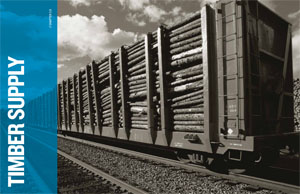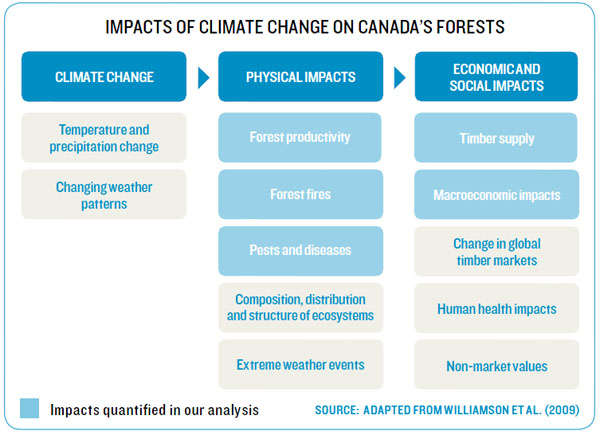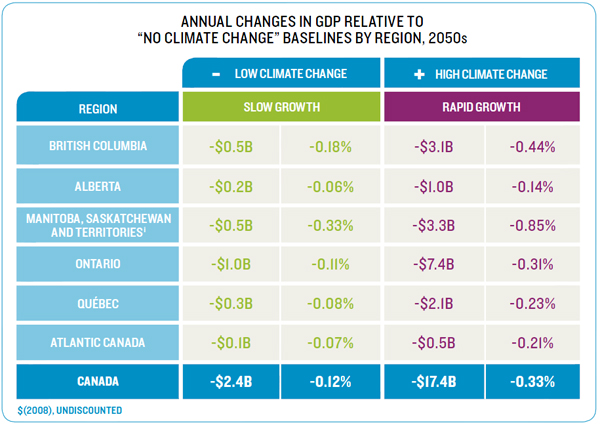Paying the Price – Timber Supply
Climate change adds a new threat to Canadian timber supply.
 Canada is home to almost 3.5 million square kilometres of forests, representing 10% of global forest cover and 30% of the boreal forest. These forests clean our water and our air, shelter many species, provide us with recreation values, absorb and store carbon, and support a forest industry that drives 1.7% of our GDP. Climate change will have real consequences for Canada’s forest industry and cascading effects will impact other sectors. GDP could fall by 0.1% to 0.3% by mid-century.
Canada is home to almost 3.5 million square kilometres of forests, representing 10% of global forest cover and 30% of the boreal forest. These forests clean our water and our air, shelter many species, provide us with recreation values, absorb and store carbon, and support a forest industry that drives 1.7% of our GDP. Climate change will have real consequences for Canada’s forest industry and cascading effects will impact other sectors. GDP could fall by 0.1% to 0.3% by mid-century.
Forests are sensitive to changes in weather and climate. Canadian researchers, including in the Canadian Forest Service at Natural Resources Canada, are studying the potential impacts of climate change on Canada’s forests. In a changing climate, forest fire activity is expected to increase, affecting timber supplies and leading to higher fire management and control costs. An increase in pest disturbance is likely over the next few decades, and more frequent and intense extreme weather events including wind and ice storms could damage trees and industrial operations. Warmer temperatures and higher levels of carbon dioxide in the atmosphere may accelerate productivity under certain conditions.
The distribution and composition of ecosystems — including forests — is shifting, with some species gaining suitable habitat and others losing it. In a global economy, impacts of climate change on forests outside of Canada could have cascading effects on our forest industry.

Timber impacts due to climate change
The effect of climate change on timber quantities intensifies over time and varies regionally with western parts of the country faring worse than eastern parts. The analysis shows that timber quantities decrease in all regions as climate change heightens over time. These decreases range from 1-5% in the 2020s to 2-23% in the 2080s. But these impacts are more noticeable for western Canada than for eastern Canada. For example, according to the analysis, timber quantities could fall by between 9% and 14% in Alberta, between 7% and 11% in Manitoba, Saskatchewan, and the Territories, and between 5% and 8% for British Columbia by the 2050s. In Québec, timber quantities could fall by 1% to 2% by the 2050s. Our estimates reflect expectations of broad trends rather than specific events. Recent experience with the mountain pine beetle in British Columbia, projected to result in an estimated loss of 23% of provincial timber volume by 2015,suggests that our results are conservative for British Columbia.

ECONOMIC IMPACTS
- Changes to timber quantities due to climate change in the 2050s could reduce national GDP by up to 0.3% — or about $17 billion — compared to a case with no climate change.
- Climate change dampens economic activity and productivity, with GDP impacts most pronounced for Manitoba, Saskatchewan and the Territories, and for British Columbia.
- The cumulative costs of changes in timber supply over the next 70 years due to climate change range widely, from $25 billion to $176 billion for the country as a whole depending on the scenario.

ADAPTATION STRATEGIES
Several strategies exist to prepare for and offset the physical and economic impacts of climate change on forests. They include operational and management changes, such as shortening rotation lengths and minimizing the spread of pests. They can also involve behavioural change, such as shifting forest management practices away from historical norms toward practices that embed principles of risk management, adaptive management, and ecosystem resilience. According to our analysis, the benefits of adaptation outweigh the costs in every region and scenario.
























